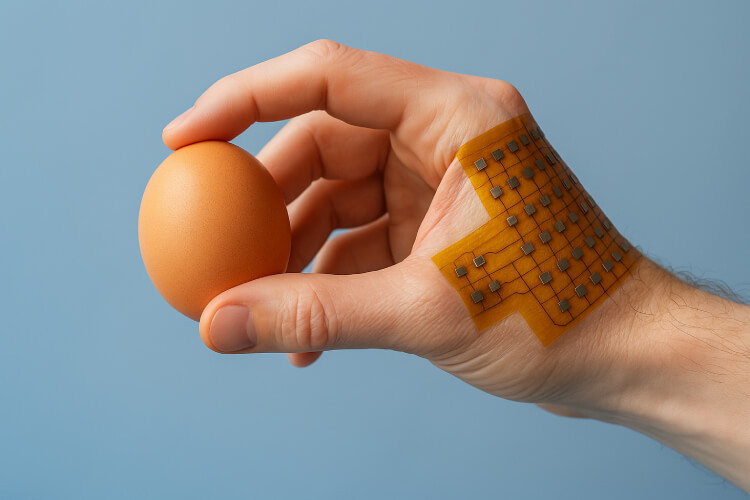Electronic Skin for Robots Enables Touchless Control
Insights | 12-05-2025 | By Robin Mitchell

Robots today can run, leap, and perform delicate surgeries—but when it comes to something as simple as holding an egg, many still fall short. Despite the leaps in robotic performance, a fundamental challenge persists: the lack of a skin-like interface capable of sensing and responding to subtle stimuli. Without such feedback, tasks requiring finesse and adaptability remain out of reach for even the most advanced machines.
Key Takeaways:
- New e-skin breakthrough: German researchers have developed an ultra-thin, flexible electronic skin capable of detecting and mapping magnetic fields in real time.
- Precise and energy-efficient: The system uses giant magnetoresistance (GMR) and electrical resistance tomography (ERT) to achieve 1mm resolution while supporting low-power operation.
- Touchless interaction potential: The technology could revolutionise gesture recognition in robotics, enabling more intuitive and natural human–machine interfaces.
- Applicable beyond robotics: Its high sensitivity may benefit fields such as extended reality (XR), healthcare monitoring, and wearable assistive technologies.
Why is robotic skin so hard to develop? What makes human-like interaction so difficult to replicate, and could a recent breakthrough in electronic skin technology offer a solution?
Challenges with Robotic Skin and Interfaces
Robotic systems have undergone a significant transformation over the years, showcasing impressive capabilities that often surpass human abilities. Some robotic systems can perform backflips with ease, while others can outrun the fastest human on the planet. Furthermore, robotic systems have become adept at performing delicate surgeries, demonstrating a level of precision and finesse that is unmatched by their human counterparts. These advancements have undoubtedly revolutionised various industries, including manufacturing, healthcare, and logistics, and have paved the way for a new era of automation.
However, despite their impressive capabilities, robotic systems still face numerous challenges that hinder their ability to perform even the most basic human tasks. One of the most significant challenges faced by robotic systems is the lack of skin, which makes it difficult for them to measure pressure and perform precise motion control. For instance, holding an egg requires a great deal of finesse and control, as even the slightest movement can cause the egg to break. However, robotic systems often struggle to achieve this level of precision due to their inability to sense subtle changes in pressure and texture.
Why Tactile Feedback Still Eludes Advanced Robotics
Another challenge faced by robotic systems is gesture and fine motion control. Understanding the texture of objects and the way they move in a hand is crucial for performing delicate tasks, such as handling fragile objects or performing intricate procedures. While robotic systems have made significant progress in this area, they still lag behind human capabilities, often resulting in inaccurate movements and loss of control.
The development of electronic skins has shown promise in addressing some of these challenges, but their widespread adoption remains elusive. Several electronic skins have been developed over the years, but none have been successfully deployed on a large scale. This is often due to various factors, including challenges with flexible electronics, ease of damage, and the difficulty of interfacing with large quantities of sensors.
One of the primary challenges faced by electronic skins is the need for flexible electronics that can conform to the shape of the skin. Traditional electronic components, such as silicon chips and wires, are rigid and inflexible, making them unsuitable for use in electronic skins. Researchers have been exploring various materials and technologies to develop flexible electronic components, but significant technical hurdles remain.
German scientists develop revolutionary electronic skin for humans and robots
Researchers at the Helmholtz-Zentrum Dresden-Rossendorf in Germany have successfully developed a new electronic skin that can detect and track changes in magnetic fields. The development of this new e-skin could see a major change in how humans and robots interact with their surroundings, potentially allowing for touchless interactions.
In the 2025 study published in Nature Communications, researchers described how they integrated giant magnetoresistance (GMR) with electrical resistance tomography (ERT) to deliver real-time, spatially continuous magnetic field mapping over a 120×120mm2 area. This configuration provides a 1mm resolution, enabling more precise localisation of gestures and movements than many existing flexible sensor technologies.
Layered Architecture Enabling High-Resolution Magnetic Sensing
The new e-skin is made up of three layers, the first of which is an ultra-thin, breathable membrane that allows for air and moisture to pass. The second layer is a magnetosensitive material that is able to detect changes in magnetic fields, and the third layer is a central processing unit that is able to read the changes in the magnetosensitive layer and determine the location of the magnetic field.
Unlike conventional designs that rely on discrete sensor arrays, the e-skin developed by Helmholtz-Zentrum implements a continuous sensing architecture. This allows for uniform responsiveness across the surface, eliminating blind spots and enabling more consistent haptic interaction for human–machine interfaces and wearable robotics.
The new e-skins use a tomography-based signal-processing method that is able to determine the exact location of the source of the magnetic field. This is done by using a single analysis unit that is able to process the data from the magnetosensitive layer, and then using that data to determine the location of the source.
The use of a single analysis unit to process the data is a major advantage of the new e-skin, as it allows for a much more compact design. This also allows for the e-skin to be much more energy efficient, and therefore last longer on a single charge.
Compact Design and Low-Power Operation for Extended Use
Energy efficiency is further supported by the design’s low-power signal acquisition methodology. The integration of GMR sensors with ERT reduces the need for high-frequency sampling and complex multiplexing, which typically increase energy demands in wearable systems. As a result, the system supports sustained operation for real-time applications in extended reality (XR) and soft robotics.
The researchers have also stated that the new e-skin is able to detect magnetic fields that are much weaker than those that are currently detectable by other electronic skins. This allows for the e-skins to be used in a wider range of applications, and also allows for the e-skins to be used in more sensitive environments.
This extended sensitivity range is crucial for applications where conventional sensors underperform—such as detecting low-intensity magnetic cues in cluttered environments or interfacing with bio-integrated electronics. According to the research team, the approach holds promise for future use cases in minimally invasive human–robot collaboration and precision healthcare diagnostics.
Could the New E-Skin Change the Future of Robotics?
While the electronic skin developed by the researchers at the Helmholtz-Zentrum Dresden-Rosendorf in Germany is an excellent step in the right direction, its practicality and potential applications are yet to be determined. In most cases, the technology developed by researchers will be used in another project to advance that field. What the researchers have created, however, is certainly clever, and it appears to be far more advanced than previously developed devices. If it can be integrated successfully into robotic systems and demonstrated in practical applications, it is possible that this new technology could find its way into the future generation of robotic developments.
One of the primary advantages of the new electronic skin is its ability to detect and track changes in the magnetic field. Unlike other electronic skins that rely on sensors to detect pressure and texture, this skin utilises a magnetosensitive layer to detect changes in the magnetic field, allowing it to determine the location of a magnetic source. This technology could be particularly beneficial for robotic systems that require precise motion control and gesture recognition.
The ability to detect magnetic fields also presents an opportunity for the development of touchless interfaces. The new electronic skin can be used to detect subtle changes in the magnetic field generated by a user's hand, allowing for gestures to be recognised. This technology could be used in conjunction with other sensors to create a system that is able to detect and respond to user gestures. This would not only improve the dexterity of robotic systems but also provide a more natural and intuitive interface for users.
The new electronic skin is also highly energy efficient, which is essential for robotic systems that are often required to operate for extended periods of time. The use of a single analysis device to process the data from the magnetosensitive layer not only reduces the overall size of the skin but also enables it to operate for longer periods of time. This energy efficiency is particularly important for robotic systems that are designed to operate in remote or inaccessible areas where power sources may be limited.
The development of electronic skins is a crucial step in the advancement of robotic systems. The ability to detect pressure, texture, and other subtle changes in the environment is essential for creating robotic systems that are able to interact with their surroundings in a natural and intuitive way. The new electronic skin developed by the German researchers is an excellent example of how researchers are working towards this goal, and its potential applications in the field of robotics are vast. If it can be successfully integrated into robotic systems and demonstrated in practical applications, the future of robotics could be significantly changed.

